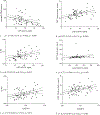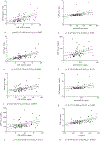Soluble CD14 is subtype-dependent in serum but not in cerebrospinal fluid in people with HIV
- PMID: 35313166
- PMCID: PMC10373575
- DOI: 10.1016/j.jneuroim.2022.577845
Soluble CD14 is subtype-dependent in serum but not in cerebrospinal fluid in people with HIV
Abstract
Monocytes and macrophages activation are crucial in human immunodeficiency virus (HIV) central nervous system (CNS) infection and HIV associated neurocognitive disorders (HAND) pathogenesis. The soluble form of CD14 (sCD14) is a marker of monocyte activation. We hypothesized that sCD14 levels would be lower in people with HIV-1 subtype C (HIV-1C) than in HIV-1B owing to a variant Tat cysteine dimotif (C30S31) with reduced chemotactic activity. A total of 68 paired cerebrospinal fluid (CSF) and blood samples from people with HIV (PWH); 27 samples of the HIV-1B subtype and 40 of the non-B HIV-1 subtypes (including 26,HIV-1C), and 18 HIV-negative controls were included. sCD14 levels were quantified using a high-sensitivity enzyme-linked immunosorbent assay. sCD14 increase in serum, but not in CSF, was higher in samples from HIV-1B than HIV-1C (p = 0.002; Cohen's d, 0.7). CSF or serum sCD14 values were not correlated with global deficit score or specific cognitive domains. The impact of HIV-1 on monocyte stimulation biomarkers evaluated by sCD14 in serum was subtype-dependent, higher in HIV-1B than HIV-1C, consistent with reduced chemotactic activity as hypothesized.
Keywords: Cerebrospinal fluid; HIV-1; HIV-associated neurocognitive disorders; Soluble CD14; Subtypes.
Copyright © 2022 Elsevier B.V. All rights reserved.
Conflict of interest statement
Conflicts of Interest and Source of Funding
The authors declare that there are no conflicts of interest regarding the publication of this article.
This research was supported by NIH R21 MH76651 (principal investigators: R. Ellis and S. de Almeida) and CFAR International Pilot Grant P30 AI036214 (principal investigator: S. de Almeida). Funding organizations did not contribute to the design and conduct of the study; collection, management, analysis, and interpretation of the data; preparation, review, or approval of the manuscript; and decision to submit the manuscript for publication.
Statistical analysis was performed by Bin Tang and Prof. Florin Vaida.
Declaration of Competing Interest
The authors declare that there are no conflicts of interest regarding the publication of this article.
Figures



Similar articles
-
Cerebrospinal fluid CD14++CD16+ monocytes in HIV-1 subtype C compared with subtype B.J Neurovirol. 2023 Jun;29(3):308-324. doi: 10.1007/s13365-023-01137-z. Epub 2023 May 23. J Neurovirol. 2023. PMID: 37219809 Free PMC article.
-
Higher Cerebrospinal Fluid Soluble Urokinase-type Plasminogen Activator Receptor, But Not Interferon γ-inducible Protein 10, Correlate With Higher Working Memory Deficits.J Acquir Immune Defic Syndr. 2022 May 1;90(1):106-114. doi: 10.1097/QAI.0000000000002924. J Acquir Immune Defic Syndr. 2022. PMID: 35090158 Free PMC article.
-
Soluble CD14 in cerebrospinal fluid is associated with markers of inflammation and axonal damage in untreated HIV-infected patients: a retrospective cross-sectional study.BMC Infect Dis. 2016 Apr 21;16:176. doi: 10.1186/s12879-016-1510-6. BMC Infect Dis. 2016. PMID: 27103116 Free PMC article.
-
Cerebrospinal fluid immune markers and HIV-associated neurocognitive impairments: A systematic review.J Neuroimmunol. 2021 Sep 15;358:577649. doi: 10.1016/j.jneuroim.2021.577649. Epub 2021 Jun 30. J Neuroimmunol. 2021. PMID: 34280844
-
Signatures of HIV-1 subtype B and C Tat proteins and their effects in the neuropathogenesis of HIV-associated neurocognitive impairments.Neurobiol Dis. 2020 Mar;136:104701. doi: 10.1016/j.nbd.2019.104701. Epub 2019 Dec 11. Neurobiol Dis. 2020. PMID: 31837421 Review.
Cited by
-
The default mode network is affected in the early stage of simian immunodeficiency virus infection: a longitudinal study.Neural Regen Res. 2023 Jul;18(7):1542-1547. doi: 10.4103/1673-5374.360244. Neural Regen Res. 2023. PMID: 36571360 Free PMC article.
-
Cerebrospinal fluid CD14++CD16+ monocytes in HIV-1 subtype C compared with subtype B.J Neurovirol. 2023 Jun;29(3):308-324. doi: 10.1007/s13365-023-01137-z. Epub 2023 May 23. J Neurovirol. 2023. PMID: 37219809 Free PMC article.
-
Differential associations of anti-cytomegalovirus antibodies and soluble CD14 levels with immunosenescence in people living with HIV on long term antiretroviral therapy.Immun Ageing. 2024 Dec 21;21(1):87. doi: 10.1186/s12979-024-00491-8. Immun Ageing. 2024. PMID: 39709460 Free PMC article.
References
-
- Albini A, Benelli R, Giunciuglio D, Cai T, Mariani G, Ferrini S, Noonan DM, 1998. Identification of a novel domain of HIV tat involved in monocyte chemotaxis. J. Biol. Chem. 273, 15895–15900. - PubMed
-
- Ancuta P, Kamat A, Kunstman KJ, Kim E-Y, Autissier P, Wurcel A, Zaman T, Stone D, Mefford M, Morgello S, Singer EJ, Wolinsky SM, Gabuzda D, 2008. Microbial translocation is associated with increased monocyte activation and dementia in aids patients. PLoS One 3 (6), e2516. 10.1371/journal.pone.0002516. - DOI - PMC - PubMed
-
- Antinori A, Arendt G, Becker JT, Brew BJ, Byrd DA, Cherner M, Clifford DB, Cinque P, Epstein LG, Goodkin K, Gisslen M, Grant I, Heaton RK, Joseph J, Marder K, Marra CM, McArthur JC, Nunn M, Price RW, Pulliam L, Robertson KR, Sacktor N, Valcour V, Wojna VE, 2007. Updated research nosology for HIV-associated neurocognitive disorders. Neurology 69, 1789–1799. - PMC - PubMed
-
- Becher B, Fedorowicz V, Antel JP, 1996. Regulation of CD14 expression on human adult central nervous system-derived microglia. J. Neurosci. Res. 45, 375–381. - PubMed
MeSH terms
Substances
Grants and funding
LinkOut - more resources
Full Text Sources
Medical
Research Materials

